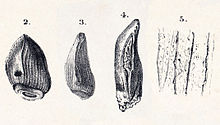Cardiodon
| Cardiodon Temporal range: late Bathonian
~ | |
|---|---|

| |
| Holotype tooth seen from two different angles (2–3), another tooth (4) and a close-up of the surface of the tooth (5) | |
| Scientific classification | |
| Domain: | Eukaryota |
| Kingdom: | Animalia |
| Phylum: | Chordata |
| Clade: | Dinosauria |
| Clade: | Saurischia |
| Clade: | †Sauropodomorpha |
| Clade: | †Sauropoda |
| Clade: | †Turiasauria |
| Genus: | †Cardiodon Owen, 1841 |
| Species: | †C. rugulosus
|
| Binomial name | |
| †Cardiodon rugulosus Owen, 1844
| |
| Synonyms | |
| |
Cardiodon (meaning "heart tooth", in reference to the shape) was a herbivorous genus of sauropod dinosaur, based on a tooth from the late Bathonian-age Middle Jurassic Forest Marble Formation of Wiltshire, England. Historically, it is very obscure and usually referred to Cetiosaurus, but recent analyses suggest that it is a distinct genus, and possibly related to Turiasaurus. Cardiodon was the first sauropod genus named.[1]
History and taxonomy
[edit]Richard Owen named the genus for a now-lost tooth, part of the collection of naturalist Joseph Chaning Pearce, found near Bradford-on-Avon, but did not assign it a specific name at the time. The generic name is derived from Greek καρδία, kardia, "heart", and ὀδών, odon, "tooth", in reference to its heart-shaped profile.[2] A few years later, in 1844, he added the specific name rugulosus, meaning "wrinkled" in Latin.[3] Cardiodon was the first sauropod given a formal name to, though Owen was at the time completely unaware of the sauropod nature of the find.
Within a few decades, he and others were viewing Cardiodon as a possible synonym of his most well-known sauropod genus, Cetiosaurus.[4][5] Richard Lydekker formalized this view in a roundabout way in 1890, by assigning Cetiosaurus oxoniensis to Cardiodon on the basis of teeth from Oxfordshire associated with a skeleton of C. oxoniensis.[6] He also added a second tooth (BMNH R1527) from the Great Oolite near Cirencester, Gloucestershire.[6] More typically, Cardiodon has been assigned to Cetiosaurus, sometimes as a separate species Cetiosaurus rugulosus,[7] in spite of its priority.
In 2003, Paul Upchurch and John Martin, reviewing Cetiosaurus, found that there is little evidence to assign the C. oxoniensis teeth to the skeleton, and the "C. oxoniensis" teeth differ from the Cardiodon teeth (Cardiodon teeth are convex facing the tongue); therefore, they supported Cardiodon being retained as its own genus.[8] Upchurch et al. (2004) repeated this assessment, and found that though the teeth have no known autapomorphies, they are those of a eusauropod.[9] More recently, Royo-Torres et al. (2006), in their description of Turiasaurus, pointed out Cardiodon as a possible relative to their new, giant sauropod, placing it in the Turiasauria.[10] Earlier, Cardiodon had been usually assigned to the Cetiosauridae or a Cardiodontidae of its own.
Description
[edit]The original tooth shows, as far as can be deduced from the surviving illustrations, the rare combination of being spatulate and having a convex inner side, though the convexity is slight. Its crown is short and wide, slightly curving to the inside. The outer side is strongly convexly curved from the front to the rear. On this side a shallow groove is present, running parallel to the rear edge. The crown tapers towards its tip. The edges have no denticles. The enamel shows the little wrinkles to which the specific name refers.[8]
Paleobiology
[edit]As a sauropod, Cardiodon would have been a large, quadrupedal herbivore,[9] but because of the scanty remains, much more cannot be said.
References
[edit]- ^ Taylor, Michael P., (2010), "Sauropod dinosaur research: a historical review", pp. 361–386 in: Richard T. J. Moody, Eric Buffetaut, Darren Naish and David M. Martill (eds.), Dinosaurs and Other Extinct Saurians: a Historical Perspective. Geological Society of London, Special Publication 343
- ^ Owen, R. (1841). Odontography, Part II. Hippolyte Baillière. 655 p.
- ^ Owen, R. (1844). Odontography, Part III. Hippolyte Baillière. 655 p.
- ^ Phillips, J. (1871). Geology of Oxford and the Valley of the Thames. Clarendon Press:Oxford, 529 p.
- ^ Owen, R. (1875). Monographs of the fossil Reptilia of the Mesozoic formations (part III) (genera Bothriospondylus, Cetiosaurus, Omosaurus). Palaeontographical Society Monographs 29:15-93.
- ^ a b Lydekker, R. (1890). Suborder Sauropoda. In: Lydekker, R. (ed.). Catalogue of the Fossil Reptile and Amphibia of the British Museum (Natural History). Part 1. Taylor and Francis:London, p. 131–152.
- ^ Steel, R. (1970). Part 14. Saurischia. Handbuch der Paläoherpetologie/Encyclopedia of Paleoherpetology. Part 14. Gustav Fischer Verlag:Stuttgart, p. 1–87.
- ^ a b Upchurch, P.M., and Martin, J. (2003). The anatomy and taxonomy of Cetiosaurus (Saurischia, Sauropoda) from the Middle Jurassic of England. Journal of Vertebrate Paleontology 23(1):208-231.
- ^ a b Upchurch, P.M., Barrett, P.M., and Dodson, P. (2004). Sauropoda. In: Weishampel, D.B., Dodson, P., and Osmólska, H. (eds.). The Dinosauria (2nd edition). University of California Press:Berkeley, p. 259–322. ISBN 0-520-24209-2
- ^ Royo-Torres, R., Cobos, A., and Alcalá, L. (2006). A giant European dinosaur and a new sauropod clade. Science 314:1925-1927.












